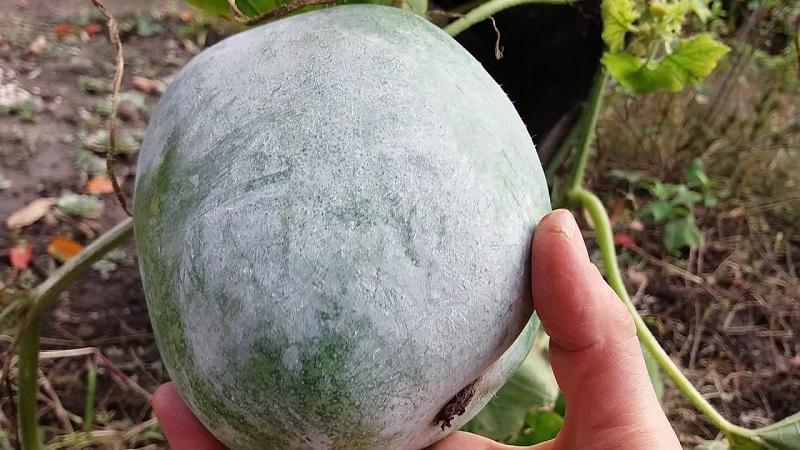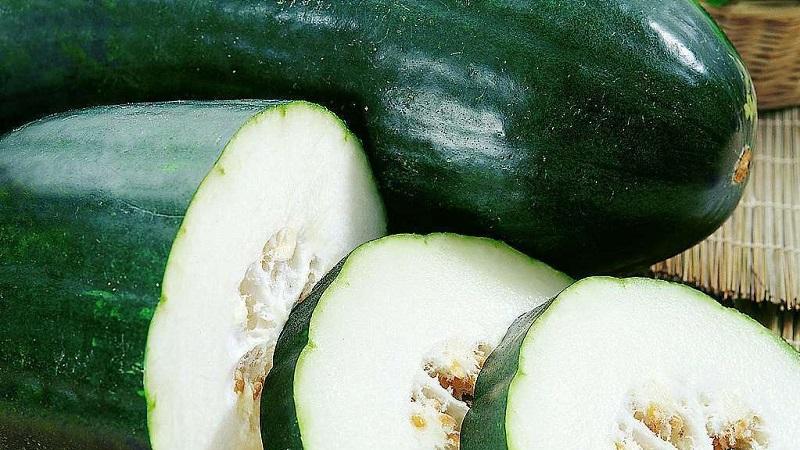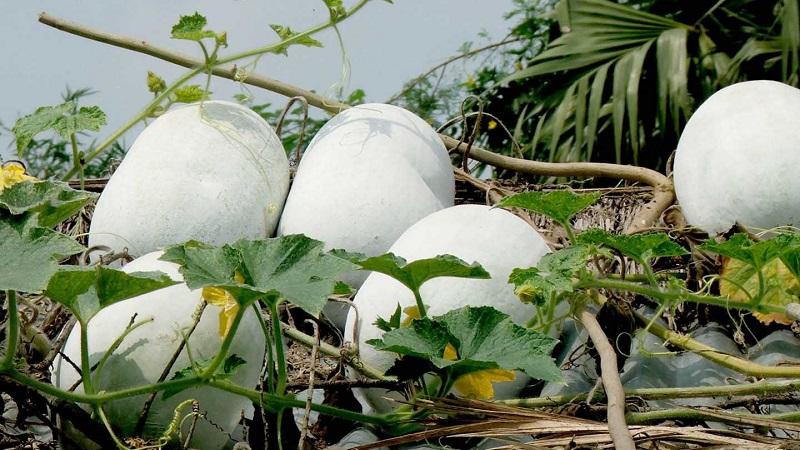Medicinal properties of wax gourd and features of its cultivation
Waxy, or winter, pumpkin Chenzhou (Benincasa variety) is most often grown in Latin America, Indonesia and in its homeland - China. However, the popularity of the variety is gaining momentum. Due to its resistance to difficult weather conditions, it began to be grown in our country.
Winter squash is a delicious vegetable that is loaded with nutritional benefits. It is easy to care for and can be stored for a long time. Wax gourd has found its use in both cooking And medicine, and in cosmetology.
Description of culture
The plant belongs to the group of liana crops. The faceted stems reach 4 m. The wax gourd has much smaller leaves compared to other species. The flowers of the plant have an orange tint; after flowering, fruits appear in their place. Green pumpkins are covered with a slight waxy coating.
The vegetables themselves are light green in color and oblong in shape, growing up to half a meter in length. Their weight reaches 10 kg. Pumpkin ripens at the end of August or the beginning of September. Even with a delicate shell, the vegetable is stored longer than other varieties: pumpkin tends to lie without spoiling for up to 3 years at 25°C. This occurs due to a waxy coating.
The white flesh of winter squash is very juicy and has a homogeneous mass. It tastes sweet and sour. Wax gourd contains B vitamins and minerals such as iron, potassium, phosphorus, sodium and calcium. The vegetable is also useful for normalizing the central nervous system and increasing the performance of the cardiovascular system. In eastern countries, pumpkin is used as a diuretic, analgesic and antipyretic agent.

Healing qualities of the plant
The Benincasa variety is unique in that the fruit contains useful enzymes that are not found in any other variety. That is why Tibetan healers cultivate it in large quantities in order to make potions from the resulting raw materials.
All parts of the plant are used in Eastern medicine in a variety of ways:
- as an aphrodisiac;
- as a laxative;
- for the prevention and removal of parasites from the body;
- to increase appetite and improve gastrointestinal function;
- from nervous system disorders;
- as an antifever agent;
- to remove excess fluid from the body (as a diuretic);
- in the treatment of sexually transmitted infections;
- to increase lactation in nursing mothers.
Wax gourd is also used for weight loss.
Doctors recommend the Benincasa variety for diabetics, hypertensive patients, people with diseases of the urinary organs and myocardial ischemia. The vegetable improves metabolic processes in the body. Doctors advise eating it every day as a diuretic and anti-inflammatory agent.
On a note. Wax gourd copes well with swelling of the hands and feet and normalizes blood pressure.
Residents of China use flower buds and young pumpkin leaves for food. Tendrils and shoots are used as spices (instead of herbs). From the seeds of the vegetable, a fat-rich oil is obtained, suitable for medicinal use and food consumption.
There is an opinion that Benincase acts as a normalizing gastric microflora and a thirst quencher. In addition, wax gourd rids the body of excess starch and has antipyretic properties.Since it acts as a diuretic, it is used for chronic nephritis and edema, including in expectant mothers.
The pulp of the fruit acts as an anesthetic when used externally and internally. The juice of the vegetable is used to treat fever and some diseases of the epidermis. Seeds used as a sedative and tonic.
On a note. The Chinese believe that wax gourd seeds prolong a person's life.
In Tibetan medicine, Benincase is used for medicinal purposes. The list of diseases that are treated with this vegetable is quite large:
- arthritis;
- stomach pathologies (for example, peptic ulcer);
- obesity of any degree;
- diseases of the urinary organs;
- gastritis;
- vascular atherosclerosis.
In addition, Benincasa juice frees the body from excess radiation.
Pumpkin has practically no contraindications. The exception is individual intolerance to the product. Its use also does not produce side effects.
 Winter pumpkin is valued not only for its medicinal properties: it is widely used in cooking throughout the year. When preserved, the vegetable goes well with cucumbers, peppers and tomatoes. Many delicious dishes are prepared from Benincasa: it can be canned, stewed, made into soups and porridges. The young vegetable is also eaten raw.
Winter pumpkin is valued not only for its medicinal properties: it is widely used in cooking throughout the year. When preserved, the vegetable goes well with cucumbers, peppers and tomatoes. Many delicious dishes are prepared from Benincasa: it can be canned, stewed, made into soups and porridges. The young vegetable is also eaten raw.
Delicious and healthy candies are also made from winter pumpkin. Simply cut the vegetable into small slices and sprinkle with sugar or powdered sugar. For variety, add cinnamon or lemon juice to the powder.
Pumpkin seeds, after roasting, have a high calorie content and excellent taste. They are good to take on a long journey and use as a sedative.
Fruit characteristics and yield
An unripe pumpkin is light green in color, has a sticky waxy coating, and has stiff bristles.Ripe fruits acquire a darker shade, a thick layer of waxy coating and a whitish coating. This “equipment” allows the vegetable to be stored for a long time and not lose its properties.
The ripening period of the crop is 75-80 days from the appearance of the first shoots. The average yield of Benincaza is up to 12 fruits per bush. The weight of a ripe vegetable reaches 7-10 kg, and in exceptional cases the weight of an overripe fruit can be more than 15 kg.
Pumpkin contains 5-6% dry matter and 30-34 mg of ascorbic acid per 1 kg of product.
How to grow wax gourd
Benincasa is an unpretentious plant and is easy to grow. To obtain high yields, the soil is well fertilized with humus, adding it directly to the planting holes, and a handful of ash is also poured there.
As the soil warms up to 10°C, seeds are sown. Benincasa has a high germination rate, so it is enough to place two grains in each hole. Bury the seed 3-4 cm deep. Benincasa is characterized as a frost-resistant crop; it is not afraid of temperature changes down to -4°C.
Vegetables are planted at a distance of 60 cm from each other in a row. Row spacing is left at approximately 1.5 m. If the garden is small, it is permissible to reduce the space between rows to 70 cm.
Important! Benincasa can be grown next to its relatives, since this pumpkin does not cross-pollinate with them.
The plant reaches 4 m in height, so it is best to grow wax gourd on a trellis. If it is not there, pegs are hammered nearby. For good fruiting, pinch the tops above the 15th leaf and remove excess shoots.

Growing winter squash from seedlings
The seedling growing method is considered optimal.At the end of April (or rather, a month before transplanting the seedlings into open ground), two grains 1-2 cm deep are planted in separate peat pots. When shoots appear, the weaker plant is removed.
At the end of May, holes in the garden are prepared in a row with an interval of at least 60 cm, watered with boiling water and seedlings are placed there. Then the planting is mulched with humus.
On a note. Many gardeners prefer film coating. The optimal temperature for Benincasa is 25-30°C. A barrier in the form of a film will create an optimal microclimate for crop growth and fruit ripening.
At first, the seedlings are watered daily. To prevent the bushes from being dense, a trellis is installed near them and the shaping is carried out by removing the side shoots.
Care
Benincasa is not afraid of lack of moisture, but it is better to prevent this and water it regularly with warm water. Every 10 days during the growing season, the plants are fed with a solution of manure in a ratio of 1/10, 2 liters per sprout. Pumpkin needs a sunny place; the best fruits are obtained from the top of the vines, on which the sun shines all day long.
The culture actively develops at a temperature of 25-30°C during the day and at least 10°C at night. The vegetable is negatively affected by shade. If the crop grows in a greenhouse, it is better to open the film slightly at noon so that insects flock to the flowers for pollination.
On a note. For successful fruit set, manual pollination is additionally performed. On a sunny day, a brush is used to transfer pollen from one flower to another. This is especially useful if the crop is grown in greenhouse conditions.
Shaping the culture
To prevent the bushes from being dense, a trellis is installed around them and formed by removing the side shoots of vines up to 1 m in length.The remaining shoots are pinched after the ovary of the first fruit.
In order for vegetables to grow mature, up to four ovaries are left on one plant. If young fruits are needed, up to twelve ovaries are left. To increase yield, in early August the main shoot is pinched after 10-12 fruits appear.

Prevention of diseases and pests
The most common pumpkin diseases are powdery mildew, mosaic and fruit rot. Most often they appear due to increased dampness, which creates favorable microflora for the development of fungi and bacteria. Pests include melon aphids and spider mites.
Prevention measures:
- When the first symptoms of powdery mildew are detected on pumpkin leaves, spray with a fungicide solution. To do this you will need 2 g of copper sulfate or 3 g of potassium permanganate. The substance is dissolved in a bucket of water.
- 1% Bordeaux mixture is treated during the formation of ovaries and leaves. For prevention, water regularly, observe crop rotation and remove the remains of affected plants.
The first signs of mosaic are noticeable even on young shoots. It is manifested by wrinkled, mosaic and chlorotic leaves. Later, the leaf blade of the affected seedlings bends inward, and over time the growth of the entire plant slows down. Pumpkin mosaic is a dangerous viral disease; affected plants are removed and burned away from the garden.
To destroy a mosaic at the initial stage:
- remove affected areas in a timely manner;
- destroy weeds;
- disinfect garden equipment.
If the plant becomes infected during the growing season, the seedlings are treated with a Farmayod solution.
Important! To prevent pumpkin infection with mosaic, the seeds are treated with a weak solution of potassium permanganate before sowing.
Rotten areas of the fruit are carefully removed with a knife. The resulting wound is wiped with aloe juice. The rubbed area dries out, but the fruit continues to develop.
To protect against aphids, weeds are first removed, then the plant is sprayed with a soap solution (100 g of ground soap per 5 liters of water) or 10% karbofos (30 g per 5 liters of liquid).
To combat spider mites, onion infusion (100 g of onion peel per 5 liters of water) or a 20% chloroethanol solution (10 g per 5 liters of liquid) will help.
One of the advantages of Benincasa is that, unlike other varieties of pumpkin, it is practically not affected by diseases and is more resistant to pests.

Reviews from gardeners
Opinions about winter squash vary: some are completely delighted with the variety, others are dissatisfied with something, and still others do not want to grow it at all.
Yuri, Orel: “I became acquainted with the Benincasa variety by chance, having tasted a pumpkin pie at my mother-in-law’s. My wife became interested in the product and took several seeds to try. My land is good, clean black soil. Last year I planted pumpkin in seedlings for the first time, but neither the germination nor the further development of the crop met my expectations. There was a minimum of fruit on the frail stems, which by the time of harvest were half as large as promised. When planting and growing, I followed all the instructions, I can’t understand what went wrong. The vegetable is good and healthy, but apparently my type of soil is not at all suitable for it.”
Yaroslav, Gelendzhik: “A few years ago, a neighbor shared some winter squash seeds. Since then I have grown this vegetable crop every year. Pumpkin is very healthy and comes in convenient sizes. One fruit is enough for my large family to eat.I store pumpkin under the sofa - a great space saver! And an even bigger advantage is that it does not cross-pollinate with other types of pumpkin. This is very important for me, since I grow several species at once. I also heard that this crop can be grown even in an apartment: for this you need a large flowerpot with a volume of about 7 liters. This is not much, considering that it puts out beautiful lashes up to 4 m. It’s a kind of decor. I want to try."
Irina, Tver: “I have been growing Benincasa winter squash for five years. I like that wax pumpkin can be easily stored at room temperature for several years, the main thing is not to rub off the protective coating. It tastes like zucchini. Children eat it raw with pleasure. Agricultural technology is practically no different from ordinary and nutmeg pumpkins. My whole family likes the vegetable; I plan to grow pumpkin all the time.”
Conclusion
Due to the high concentration of vitamins in the pulp and many useful substances and minerals, Benincasa improves immunity well in the winter season. People who regularly eat this pumpkin are less susceptible to respiratory infections. If desired, even a novice summer resident can easily grow an unusual and healthy vegetable.
See the video below for a lot of useful information about the Benincasa variety: